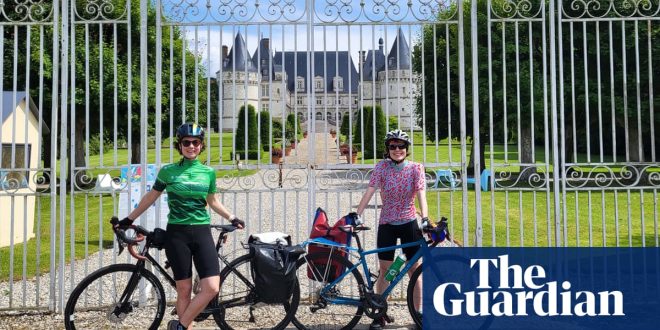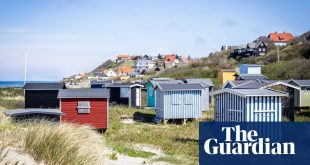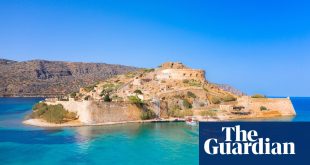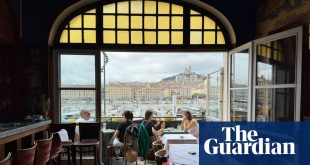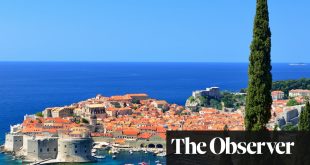I’m bashing my way through thick foliage atop a long-disused railway embankment somewhere outside Sevenoaks, using my bicycle as a battering ram against the brambles and nettles. My guide has disappeared ahead into the wilderness. Beside and beyond us are fields and views, but I can’t see them. I’m being asked to imagine, though, what this route could be, given the chance. I’m following a man who has hoped for two decades to reroute the English portion of what he believes could be a “yellow brick road” for cycling, linking London and Paris.
The existing route, the Avenue Verte (AV) was inaugurated ahead of the London 2012 Olympics, forging a symbolic and physical connection between the two capital cities. However, while the French portion was lavished with new, smoothly surfaced greenways, a lack of funding and political will meant on the English side a make-do-and-mend spirit has, until now, prevailed. Now that it’s Paris’s turn to hold the Olympic flame, thoughts have returned to this unfinished route.
Those who cycle the AV wax lyrical about the French side, so a friend and I cycled the 150 miles from Dieppe to Paris 10 days ahead of the 2024 Games. Smoothly surfaced former railway tracks, interspersed with quiet country lanes, some gravel crossings of fields and a few manageable hills, led us through pretty French villages and a gently rolling rural landscape dotted with chateaux.
Cafes and restaurants have sprung up along the route, such as Café Vélo Jaune in Dampierre-en-Bray. Others thrive in former railway stations on the path – the galettes at Les Tables De La Gare in Neufchâtel-en-Bray were excellent. Indeed, about 170 tourism-related service providers are labelled “Accueil vélo” (cyclists welcome) along the route.
The final 28 miles meanders a broad S-shaped route into Paris on traffic-free wooded paths and separate bike lanes, following the Seine and the Canal Saint-Denis. It’s a fitting end to a glorious three days, though four days would give riders more time to enjoy the sights, such as the grand sculptures in the Vexin Français regional nature park, slightly off the trail.
The English side is another story. Starting at the London Eye, the current route trudges through miles of urban sprawl, even crossing Gatwick airport, with a few pleasant off-road interludes, such as the recently upgraded Wandle trail by Morden Hall Park, before attacking the North Downs and High Weald. There are some fairly rough forest paths along the way as well as some delightful off-road rail trails.
Much of the English route was created when the National Cycle Network was founded for the millennium by my guide, John Grimshaw. But unlike in France, the UK government, local councils and tourist bodies failed to unite in upgrading it. It has fallen on cycling charity Sustrans to maintain and gradually upgrade the route with its usual pluck and enthusiastic volunteers. Many users avoid cycling the English side or cobble together their own route to the ferry at Newhaven.
John now delivers greenways with his small charity Greenways and Cycleroutes. A better Avenue Verte could, he says, be delivered at a cost of about £25m. (The upgrading of junction 10 of the M25, a few miles west, due to complete in summer 2025, is budgeted at £317m.)
John’s proposed route would instead start (or end) at Tower Bridge, following the traffic-free Thames Path and newly built protected cycle lanes out of the city, mirroring its French counterpart. Dartford, where we began our ride, is undergoing a spruce-up, attractive stone paving showcasing 1,000 years of architecture, from the 11th-century Holy Trinity Church to the Tudor Wat Tyler pub.
We cycle through a park alive with flowers and follow the river Darent, in lush foliage, for miles. While the first part of the proposed route, from London to Dartford, is all but ready, this segment to Sevenoaks needs resurfacing, rights-of-way upgrading on footpaths and bridleways to permit cycling, plus five new bridges over the Darent. For this relatively modest intervention, the route links six train stations to Sevenoaks (and more beyond) via the olde-world pretty villages of Farningham, Eynsford, Shoreham and Otford, as well as several castles (Lullington and Eynsford among them), areas of outstanding natural beauty – or AONBs (the Greensand Ridge and the High Weald) and refreshments stops galore. It would be a local resource for everyday walking and cycling trips, as well as a tourist attraction. Demand is there: between the villages of Horton Kirby and South Darenth, the local community has already clubbed together to surface a walking path that used to be a bog in winter.
This heavily wooded area, with rolling hills that we skirt rather than scale, is a fitting showcase for England’s beauty and has me smiling all the way. We follow the riverbank far beneath the towering A2 and M25 bridges, having barely seen a car. At Farningham we emerge from the wilderness beside the riverfront tables of the handsome Lion Hotel, opposite an 18th-century cattle screen – a bridge-like structure of flint and brick designed to corral cows fording the Darent. The river was considered one of the finest trout streams in England, a sign reads, and Charles Dickens reportedly fished here.
We press on past the National Trust’s Emmetts Garden café, with its broad views atop the Greensand Ridge, stopping at the Tulip Tree café in Chiddingstone, which the owners claim has the oldest working shop in the country, dating back to 1453. We count 30 bikes beneath the old coach arch and along an ancient walkway to the converted coach house.
Visit Britain says about 57,000 inbound tourist visits include cycling in some form, bringing in £63m annually, which I think is an underestimation (the Trans Pennine Trail in the Peak District yields a third of that alone, though many are local visitors). Reputable sources in fact estimate cycle tourism value at a lot more – £389m a year.
Refurbished railways, quiet roads and bridleways would lead through the Eden Valley, a short detour from Hever Castle. We veer east instead, past Tonbridge Castle and on to Tunbridge Wells, fulfilling the local council’s long-term active travel plans to link communities with routes suitable for everyday journeys (an area with among the lowest levels of everyday cycling in England). It would then be a case of reclaiming lost railways for a flatter route across the High Weald AONB to pick up the end of the existing route at Heathfield, via the charming Cuckoo Trail, a smooth off-road path shadowing the A22, to Lewes and then the Egrets Way along the Ouse, to complete the route to Newhaven.
With renewed interest around the 2024 Games, Sustrans is gathering stakeholders around potential route improvements, but raising the money is a challenge – unlike for motorways and trunk roads, there’s no long-term funding for active travel projects – and Sustrans says nothing will happen on the ground in the next five years. Active Travel England’s Chris Boardman cycled part of the Avenue Verte ahead of the 2024 Olympics, praising its transport value to local communities as well as its value as an adventure route. If the government got behind it, the returns could be huge: for a tenth of the cost of a single motorway junction upgrade, we could have something of real value to the nation, and to local communities.
Laura Laker’s trip was provided by Normandy Tourism, DFDS ferries and LeShuttle. She stayed at Hôtel Mercure La Présidence in Dunkirk, Hôtel de Normandie in Gournay-en-Bray and Campanile Conflans-Sainte-Honorine
 Top Naija News – Nigeria News, Nigerian News & Top Stories Top Naija News – Nigerian Newspapers, Nigerian News. topnaijanews is a daily Nigerian newspaper covering Latest News, Breaking News, Entertainment, Sports, Lifestyle and Politics.
Top Naija News – Nigeria News, Nigerian News & Top Stories Top Naija News – Nigerian Newspapers, Nigerian News. topnaijanews is a daily Nigerian newspaper covering Latest News, Breaking News, Entertainment, Sports, Lifestyle and Politics.
